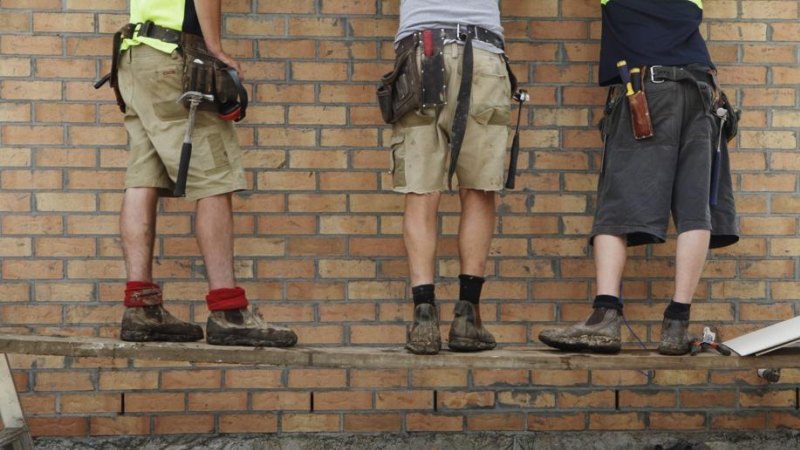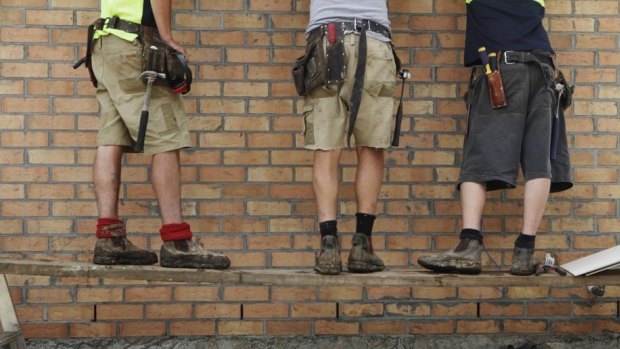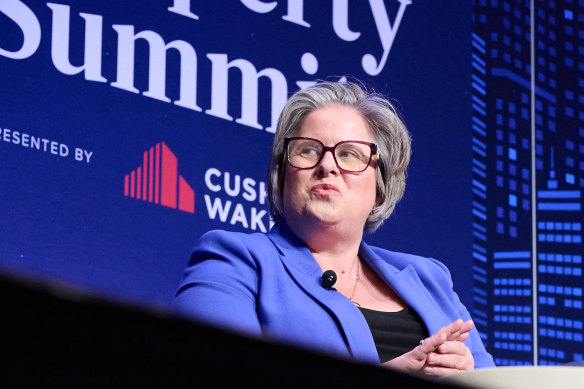Save articles for later
Add articles to your saved list and come back to them any time.
The federal government is being asked to subsidise builders who bring skilled foreign workers into the country in a bid to cut the cost of new homes, stepping up industry warnings about labour shortages ahead of sweeping changes to the migration intake.
The push comes as new figures confirm the challenge in finding the skilled workers needed to build new homes when housing costs are on the rise.
Australia needs more than 480,000 new workers over the next three years to meet growing demand for skilled tradespeople.
Australia’s migration since May last year has included 1135 carpenters and 215 plumbers.
The building industry has told the government it will need 480,000 new workers over the next three years, ranging from Australian apprentices to skilled foreign workers, to meet growing demand and replace older tradespeople as they leave the workforce.
But the idea of a $10,000 subsidy is intensely controversial when annual migration has soared above official forecasts for 400,000 new arrivals and the federal government is about to reveal new policies to bring the intake under greater control.
The Australian Constructors Association has told the government that the worker shortage is a key factor in stalling major road and rail projects, while Master Builders Australia says the foreign workers are needed to keep costs down.
“A shortage of tradies, including skilled migrant workers, is leading to higher labour costs and delays in construction timelines,” said Master Builders chief executive Denita Wawn.
“This ultimately drives up the cost of building and reduces our ability to meet our annual housing targets.”
Master Builders Australia CEO Denita Wawn says a lack of tradespeople leads to higher labour costs and delays in construction.Credit: Michael Quelch
Master Builders is seeking a federal version of a West Australian government program that offers builders a $10,000 payment for every skilled foreign worker they attract to help with the cost of the visa, moving and housing.
Behind the proposal is a warning that the industry will need 480,000 new workers by November 2026 to keep construction work at current levels, but this does not include the additional workforce needed to meet the federal government’s housing target, or its plans for renewable energy projects and new electricity transmission lines.
Engineers Australia wants the government to make it easier for overseas students to stay in Australia after they graduate with skills the country needs, citing census data about the 115,000 engineers who joined the workforce in the five years to 2021.
“Of these additional engineers, nearly 82,000 were born overseas. This means on average, Australia produced just under 6800 engineers domestically each year,” the group said.
The Australian Constructors Association, which represents big companies such as Lendlease, Acciona and Multiplex, names the labour shortage as the “key limiting variable” that has prevented the country from expanding its capacity to complete big projects.
“Over the last five years, the forward pipeline of committed engineering works increased from $50 billion to $90 billion. Yet the amount of work actually done stagnated at around $25 billion per quarter,” it told the government in its submission to the migration review.
“In other words, as the volume of commissioned construction work has increased, the industry has been unable to lift its work rate commensurately.”
Official figures disclosed to the Senate show the government issued 242,833 skilled and family permanent visas from May last year to August this year, as well as 52,005 employer nomination scheme visas over the same time.
In a question designed to find out the types of workers migrating to Australia, Liberal senator James Paterson asked for a breakdown of the jobs and was told the numbers included 1135 carpenters and 215 plumbers across those two programs.
Immigration Minister Andrew Giles has pointed to the pressure on housing as a reason to bring in more skilled workers.
“I think the biggest driver for increasing demand and one of the key aspects is, of course, one of the skill shortages that we’re experiencing is the skills we need from migrants to build the houses in Australia,” he told this masthead earlier this month.
A spokesman for Giles said the government had granted visas to 1741 carpenters across the temporary and permanent skilled programs from 1 May 2022 to 31 October 2023, as well as 602 plumbers over the same period.
Opposition immigration spokesman Dan Tehan accused the government of allowing too many migrants into the country without doing enough to attract young skilled workers who could help ease pressure on housing costs and rents.
“It speaks volumes of Labor’s failure to manage migration that 500,000 migrants will arrive in Australia this year and yet there are skills shortages across the board, particularly in the building sector,” he said.
The official figures for this year’s net migration intake are yet to be released, but the intake over the year to September 30 was close to 500,000, according to former immigration department deputy secretary Abul Rizvi, an independent commentator on the issue.
There was greater success in bringing health workers to Australia, with 16,652 nurses coming to the country in the two programs and 3228 doctors doing the same. The programs brought 4400 aged-care workers to the country from May last year to August this year.
The Western Australian government appears to be the only state jurisdiction that offers a subsidy for builders, with its Construction Visa Subsidy program offering up to $10,000 to employers who bring in migrants. It is expected to cost $11 million this financial year on the assumption it attracts 1100 people.
The Victorian government has been offering $10,000 for foreign healthcare workers who migrate to Melbourne and $13,000 for those who go to rural and regional areas under a program that aims to attract 1100 workers and is expected to end on December 31.
Cut through the noise of federal politics with news, views and expert analysis. Subscribers can sign up to our weekly Inside Politics newsletter.
Most Viewed in Politics
From our partners
Source: Read Full Article


